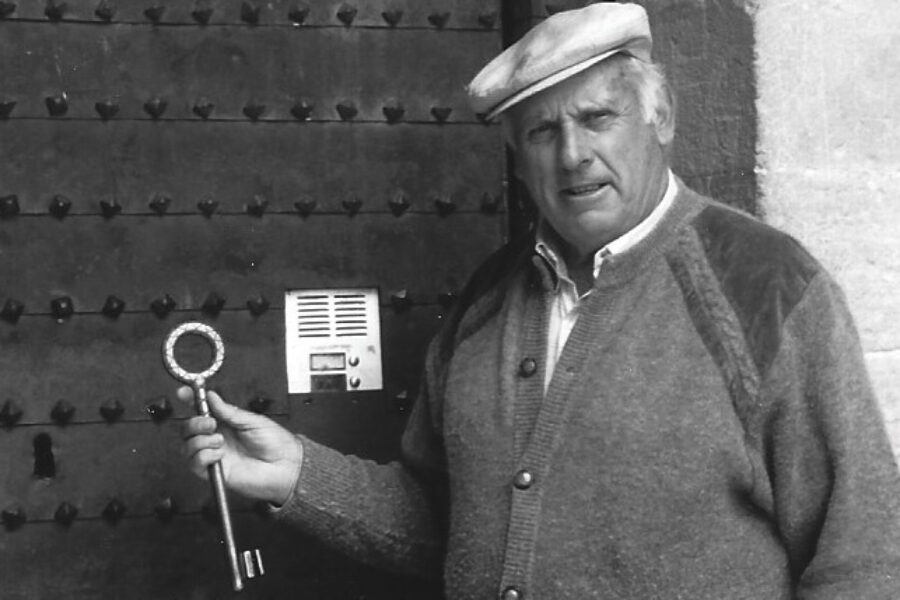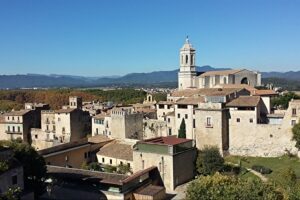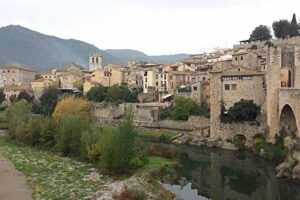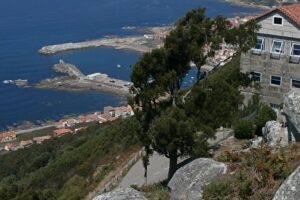Almost a quarter of a century ago, Michael and I were in Spain, making our way up from Mijas on the Costa del Sol to Seville, Cordoba, Toledo, and finally, Madrid. In those days the World Wide Web was in its infancy and Google wasn’t even a glimmer of a dream. Only printed material and maps were available to plan our trip. I used a book on Spanish inns and hotels to discover places to stay, a fax machine to make our reservations, and various guide books to tell me where we should explore. I think I kept Barnes & Nobel in business back then.

During our stay in Cordoba, we drove off the beaten track — as we always do — and went in search of a castle referred to only as restored. Now, well into the 21st Century, I find the castle we discovered so long ago was one of the filming sites for Game of Thrones and has become a tourist destination. Perhaps a tourist trap. That makes me sad. If you want to read about a kinder, gentler time — a day of magic — please join me on a trip back in time to the very late 20th century.

1997
Almodovar del Rio was not an option. It was a mandate. My husband, Michael, indulgently agreed. In all of the many books I have collected about Spain, there was one page with one sentence that drew my attention. It was the mere mention of a castle, a hill, a town—easily missed. It was enough. I had no choice in the matter. I am drawn like a magnet to the past, and I had never seen a real castle before.
In Search of a Castle

By Rabe! – Own work, CC BY-SA 3.0, https://commons.wikimedia.org/w/index.php?curid=17900151
We slowly make our ascent through the tiny town, keeping the distant castle constantly in view, while our rented Peugeot curls and curves till the road narrows and becomes little more than a pebbled trail. We park the car and decide to continue the journey on foot, lured forward by the implied comfort and companionship of a tour bus parked along the side of the road. A small rusted sign in the shape of an arrow points toward a path that reads, Castile.
In the gray mist of morning, under leaden skies, we see the ramparts of the ancient castle rising from the craggy hillside. It looks as if, with one fierce thrust, it has reared its massive head, clawing its way up from the depths, ripping giant boulders from the earth, causing them to thunder and roll, lodging here and there in scattered disarray. This castle appears to be a thing alive, that has been planted. And grew.

Far above us, we notice a herd of goats grazing on the rocky slope. They are earnest in their attack on the meager grass and move sure-footedly along the well-worn trails crisscrossing the side of the mountain like a giant spider web. A sheepdog wanders through the herd, sitting, standing, running, dogging, keeping them together. A shepherd of indeterminate age keeps a distant watch over the entire group, lagging lazily behind. The musical clanking of bell collars which encircle the necks of the goats, and the imposing castle rising from the earth, make me feel I am not only in another country, but another time.
A Hill too High
The narrow road which leads us to the castle is steeper than we originally thought, and after climbing steadily for quite a while we stop to catch our breath. Michael sits on a grassy slope and complains, “I think I’m getting too old for this.”
“Nonsense,” I reply, turning toward the road, checking on the safety of our car. “Look, the bus is gone, and no tourists have come down the mountain.”
Michael’s gaze follows my pointing finger. “I guess the driver just stopped to rest. Probably have a cigarette. Oh well, we’ve come too far to turn back now.”
He stands and together we resume our quest.
The Castle Keep

Arriving at the castle’s great wooden gate, we are greeted by the castle keep, the large iron key to the creaking gate held firmly in his hand. He is a genteel old Spaniard who speaks no English. I am amazed and delighted when Michael is able to communicate with him.
“Senor,” he begins, and then I am lost in the music of their conversation, understanding not a word. After a bit Michael turns to me and says, “The castle is privately owned. Tours are by invitation only.”
I try to hide my disappointment and turn to go. The old Spaniard begins talking to Michael once more, and their words continue to flow. Fortune smiles on us and the kindly old man tells Michael he will show us around the turrets and battlements, but unfortunately, that is all we will be allowed to see.
We enter the stronghold, walking up a cobblestone path bordered by roses and other flowering shrubs. A gardener greets us with a smile and a nod, as he prunes and plucks, shaping the greenery for the unseen owner. We are escorted not only by our host but by three roly-poly puppies, who scamper and play at our feet, our guide fussing and scolding them as we walk. I cannot understand Spanish, but the tone says, “Behave.”
Castillo en al Aire
A Tiny Bit of History
Mike interprets for me as we once again find ourselves walking uphill. The old man informs us the castle was built by King Filipe of Spain, which one I do not know, and the most recent restoration was done in 1936 when additional buildings were added to the interior grounds.
After ascending numerous steps, we enter a large courtyard and are greeted by a symphony of stone with colors in varying shades of gray and ochre. Mellow and harsh. The shapes are curved and straight. Horizontal and perpendicular. The castle soars and dips, and enfolds. The vertical surfaces are rough and hard, while the horizontal ones were worn smooth by thousands of feet walking through the centuries. This stone collage is punctuated by windows, softened by greenery, and splashed with color by pink oleander.

Our guide explains how they collected water in the medieval past and with sweeping motions tells of the use and history of the courtyard. His explanations are too fast for Michael to continue to interpret for me, and I am lost in a myriad of words. We are told the owner does not live on the premises but only comes to the castle to meditate. With the world at his feet, limitless sky above, and age-old walls enclosing him, I can’t understand why once here, he would ever want to leave.
Turrets…
The Spaniard withdraws another large key from his pocket and begins climbing a set of lichen laden stone steps. He leads us into one of the turrets and explains there once was a draw bridge that connected the turret to the main body of the castle. It appears the tower was built to keep the enemy out—a last line of defense. Later I learn that perhaps it was designed for the opposite reason.

… and Dungeons
The old Spaniard turns on his flashlight, opens another door and motions for us to follow him. There is not a shred of daylight in the narrow passage and I try to keep up with our guide as the flashlight wavers and bobs along the dark damp steps leading infinitely down. With a final turn, we reach a room that seems to be in the bowels of the earth, but in fact, it is not even at the bottom of the turret.
Gloom hovers like a shroud in the dank air around us as I struggle to become accustomed to the dark. Our guide shines his light on an old wooden grate in the middle of the floor, then hooks the grate with a rope and lifts it from its home, aiming the flashlight into the deep space. The old Spaniard becomes verbose and swirls his light in a continuous arc, washing the walls of the ominous pit with an ashen glow.
“It’s the dungeon,” Michael tells me. Jokingly he asks the Spaniard a question. The only word I understand is turistas. The gentle laughter of both men echoes off the walls of the lifeless stone chamber.

Peering down into the dungeon I notice a narrow trickle of natural light filtering into the vault, coming from a slit which has been cut into the side of the fortress; a small sign of humanity gouged from the rock by the castle’s builders. With no hope of escape, I try to imagine the desolation and despair a captive must have felt when being roughly pushed into this forbidding pit. I shiver and hug my shoulders — the imagining beyond me.
Reaching for the Sky
Turning we leave the ghosts of old enemies behind and make our way back up the tower. Our guide points to another set of stairs which lead to the very top of this, the highest turret. These he lets us climb alone. After reaching the top, with aching lungs and aching legs, we learn why.
As we look out toward the edge of the world, I understand the reasoning behind building the alcazar’s of Spain on mountain tops. You can see forever, and friend or foe, there was no way to gain access to this castle undetected.

The sky is leaden and gray. The morning remains wet and soggy. The distant countryside disappears into an amorphous mist, lending an air of ancient tension; a kingdom waiting for the sun, and the limitless vision they knew should be theirs. Inspecting the land closer at hand, modern man invades the realm as we see a bullet train race through the heart of the country on its way to Madrid.
We linger on this ancient rooftop overlooking the quiet world of Almodovar del Rio, the pueblo blanco — white town — which lies at the foot of the mountain in a pile of white walls and red roofs. The buildings look as if they were huddled together in masse, paying constant homage to the castle towering above them.

I stand, leaning back against the rough, cold stone rampart wondering, “Were there battles here? How many? Who would attack? Who could have been brave enough, driven enough to do so? Surely the advantage was to those in the castle. How could an enemy have had a chance? How did the inhabitants fill their days? Was it a better time?” I look around. The spirits that hover here do not answer.
Bidding Farewell
We progress as slowly as courtesy will allow, continuing to peer between parapets and inspecting other turrets, until finally, we reach the end, which had been our beginning.
Before taking our leave of the fortress, I ask our guide if I can take his picture. He smiles his ascent, betraying his delight. He stands there, against the aged wooden entrance, in his jaunty little hat, with his hand extended, holding the key to the castle gate. I nervously fumble with Michael’s camera. I want to get it right, this picture is important to me, and it is my only opportunity.

We bid farewell, leaving the enclosed walls, and walk around the perimeter of the edifice. Using the base of the castle for balance on the steep incline, we pick our way along the precarious path until we reach a point that leads down. I stop, frozen between two worlds, unwilling to let go, wanting to possess this time, this place; knowing the moment my hand leaves these ancient stone walls I will leave something precious behind.
“Are you coming with me?” Michael turns and asks.
Suddenly brought back to the present I reply, “Yes, of course,” as I watch him slip steadily away from me, knowing instinctively it was his rapport with the old Spaniard which had allowed us entrance into that private, ancient age. Feelings of love, tenderness, and gratitude wash over me like sunshine.
“Michael, I love you,” I call out to him, my voice ringing across the valley, as I let go of the castle wall and turn toward the goat path which will lead me back to the twentieth century and the world in which I belong.
Castillo Almodovar del Rio in 2020
It has taken 25 years and a serendipitous stumble on tales told during our first trip to Spain that causes me to look once again for any information on our castle adventure of so long ago. I learn much, but not enough detail, with a little of it (i.e., the castle was not built by King Filipe of Spain) not necessarily fitting-in to Michael’s original translation from the old Spaniard’s words.
History Condensed
Originally a Roman Fort the current structure is of Arab origin. From 758 onwards it passed into the hands of the Emirate of Cordoba in the reign of Abderraman I. In 760 AD. it became the estate of the Moorish Prince Al’delMalik Ben Qatan.
A Moorish King Abed Mohammed de Baeza, died at the gates of the Castle during the 13th century in 1226, the year in which the fort fell into Christian hands and was handed over to Fernando III ‘The Saint’. From that time on successive Spanish kings and rulers, with monikers such as D. Pedro I of Castile and Enrique II of Trastamara, Alfonso XI ‘The Just’ and Pedro I ‘The Cruel’ remodeled and expanded the castle.
Eventually, owners of the castle went from kings to counts when it was sold in 1629 to Don Francisco Corral y Guzmán, knight of the Order of Santiago. It has been in the same family ever since. By the time Doña Josefa Farina Plasencia, XII Count of Torralva inherited the castle and inspected it in the late 19th century it had deteriorated to the point that it was in an immense state of ruin.
Restoration
The Count, along with the architect, Don Alfonso Fernandez Casanova began restoration in 1901 by dynamiting a road to the castle where none had previously existed so that stone blocks for the walls and ramparts could be transported to the castle grounds. Some 800 workmen spent 36 years working to revive the monument. Don Alfonso died in 1915 and unfortunately, Doña Josefa died in 1932, several years before completion of the reconstruction. His heir, grandfather of the current owner, Fernando de Solis, and de Solis’ father, followed in the duke’s footsteps continuing to maintain the castle.
In 2001 the family decided to open the castle doors to the public and share the history preserved within the castle walls. To learn more (and if you learn more I would be curious to know about it), or plan your own visit, click on the link below:









Leave a Reply
Your email is safe with us.